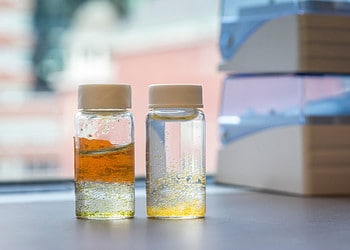It’s not easy being soft and strong at the same time — unless you’re the new hydrogel developed at the University of Cambridge. This is the first soft material that has such a huge degree of resistance to compression, the authors report.

A new material developed by researchers at the University of Cambridge looks like a squishy gel normally, but like an ultra-hard, shatterproof glass when compressed — despite being 80% water. Its secret lies in the non-water portion of the material; this consists of a polymer network with elements held together by “reversible interactions”. As these interactions turn on and off, the properties of the materials shift.
The so-dubbed ‘super jelly’ could be employed for a wide range of applications where both strength and softness are needed such as bioelectronics, cartilage replacement in medicine, or in flexible robots.
Hardy hydrogel
“In order to make materials with the mechanical properties we want, we use crosslinkers, where two molecules are joined through a chemical bond,” said Dr. Zehuan Huang from the Yusuf Hamied Department of Chemistry, the study’s first author.
“We use reversible crosslinkers to make soft and stretchy hydrogels, but making a hard and compressible hydrogel is difficult and designing a material with these properties is completely counterintuitive.”
The macroscopic properties of any substance arise from its microscopic properties — its molecular structure and the way its molecules interact. Because of the way hydrogels are structured, it’s exceedingly rare to see such a substance show both flexibility and strength.
The team’s secret lay in the use of molecules known as cucurbiturils. These are barrel-shaped molecules that the team used as ‘handcuffs’ to hold other polymers together (a practice known as ‘crosslinking’). This holds two ‘guest molecules’ inside the cavity it forms, which were designed to preferentially reside inside the cucurbituril molecule. Because the polymers are linked so tightly, the overall material has a very high resistance to compression (there isn’t much free space at the molecular level for compression to take place).
The alterations the team made to the guest molecules also slows down the internal dynamics of the material considerably, they report. This gives the hydrogel overall properties ranging between rubber-like and glass-like states. According to their experiments, the gel can withstand pressures of up to 100 MPa (14,503 pounds per square inch). An average car, for comparison, weighs 2,871 pounds.
“The way the hydrogel can withstand compression was surprising, it wasn’t like anything we’ve seen in hydrogels,” said co-author Dr. Jade McCune, also from the Department of Chemistry. “We also found that the compressive strength could be easily controlled through simply changing the chemical structure of the guest molecule inside the handcuff.”
“People have spent years making rubber-like hydrogels, but that’s just half of the picture,” said Scherman. “We’ve revisited traditional polymer physics and created a new class of materials that span the whole range of material properties from rubber-like to glass-like, completing the full picture.”
The authors say that, as far as they know, this is the first time a glass-like hydrogel has been developed. They tested the material by using it to build a real-time pressure sensor to monitor human motions.
They’re now working on further developing their glass-like hydrogel for various biomedical and bioelectronic applications.
The paper “Highly compressible glass-like supramolecular polymer networks” has been published in the journal Nature Materials.






